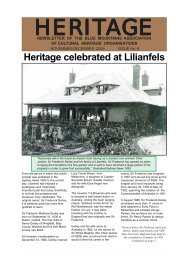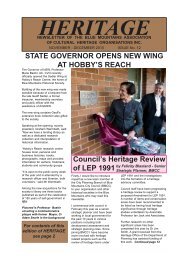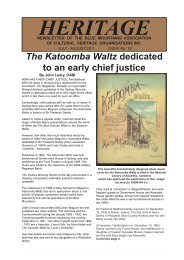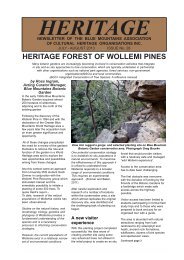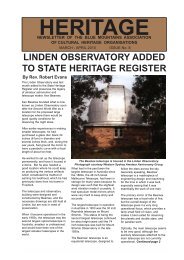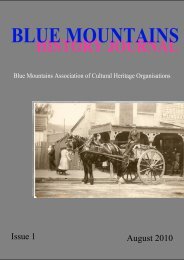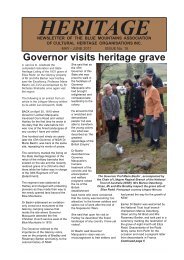Blue Mountains History Journal Issue 2
Blue Mountains History Journal Issue 2
Blue Mountains History Journal Issue 2
Create successful ePaper yourself
Turn your PDF publications into a flip-book with our unique Google optimized e-Paper software.
<strong>Blue</strong> <strong>Mountains</strong> <strong>History</strong> <strong>Journal</strong> 2; 2011<br />
Figure 3. Sydney Harbour 1858 (Blackwood 1858;<br />
Mitchell Library, SLNSW).<br />
“The sun just sinking casts a shadowy light<br />
over Sydney, which is fast becoming<br />
enveloped in a dark bluish cloud. No sound<br />
disturbs one’s reverie save the rolling of<br />
carriage wheels and the bleating of kids<br />
[goats] calling their mothers for their<br />
evening food. All is quiet, the flies float<br />
lazily in the last rays of the sun … Oh! the<br />
hill it is worthy of a painter’s brush!”<br />
(Mitchell 1980, p.224).<br />
Blanche Mitchell was fifteen and living with<br />
her widowed mother, two sisters and a<br />
brother at No.3 Upper William Street South<br />
when the Martindale family arrived, and in<br />
a brief diary entry for Friday 26 February<br />
1858 she records that<br />
“Mrs. Martindale, accompanied by Miss Smith, called.” (Mitchell 1980, p.46).<br />
Her diary entries for the years 1858 to 1861 depict a lively portrait of fashionable Sydney in the mid<br />
-nineteenth century, being full of balls and parties (both official and private), social visits, picnics,<br />
concerts and soirées. As the wife of an important colonial administrator, Mary Martindale would have<br />
been swept quickly into this world, but charity work also played a prominent role and, among other<br />
probable involvements, Mrs. Martindale became a regular visitor to the Destitute Children’s Asylum<br />
(Anonymous 1858a).<br />
Captain Ben Hay Martindale<br />
Captain Martindale began his duties in the city at the Internal Communications Department, 124-128<br />
Phillip Street, in July 1857 and in the three-and-a-bit years he spent in Australia carried out his<br />
considerable responsibilities under difficult circumstances. He was head of the department responsible<br />
for roads, railways and the electric telegraph, but he inherited a neglected and deteriorating road system<br />
and an infant rail network. His relationship with parliamentarians and the press was not a smooth one,<br />
even though he was said to have been “intelligent and conscientious” (Lee 2000, p.127) and “far-sighted<br />
and capable” (McMartin 1989, p.399). Despite paltry budget allocations and unpredictable weather<br />
conditions that hampered and even prevented new work - 1860 was a particularly difficult year with<br />
“a succession of heavy rains” (Anonymous 1860c) - he was regularly blamed for the numerous failings<br />
and inadequacies of the transport systems.<br />
His difficulties were not made easier by his own military temperament and consequent inability to adapt<br />
to the more ‘relaxed’ realities of colonial society and to what one historian has called the “rambunctious<br />
colonial politics” of NSW (Lee 2000, p.127). Self-confident and impatient with those who questioned<br />
his authority, his relationship with the Secretary for Lands & Public Works, John Robertson, was<br />
“combustible” and Henry Parkes compared him to the French dictator Louis Napoleon (Golder 2005,<br />
p.129). His over-reaction on one occasion to the criticism of a subordinate, resulting in the court-martial<br />
and imprisonment of that officer, was indicative of his character. He was subjected to public scorn and<br />
was attacked both in parliament and by the press.<br />
Governmental reorganization of his department in 1859 further challenged the independence of his<br />
authority and increased his frustration (Golder 2005, p.132). As his energy and enthusiasm for the job<br />
diminished, Martindale became convinced that he could not fulfill the responsibilities for which he had<br />
been employed and officially resigned his position in November 1860. It was a decision that has<br />
relegated him to a footnote in the history of NSW communications while his subordinate, John Whitton,<br />
went on to achieve fame as the architect of the NSW rail system. This does not do Martindale justice,<br />
for his administration was not without achievement. He produced four significant reports on the<br />
‘Internal Communications of New South Wales’, described as<br />
3 Back to Contents




